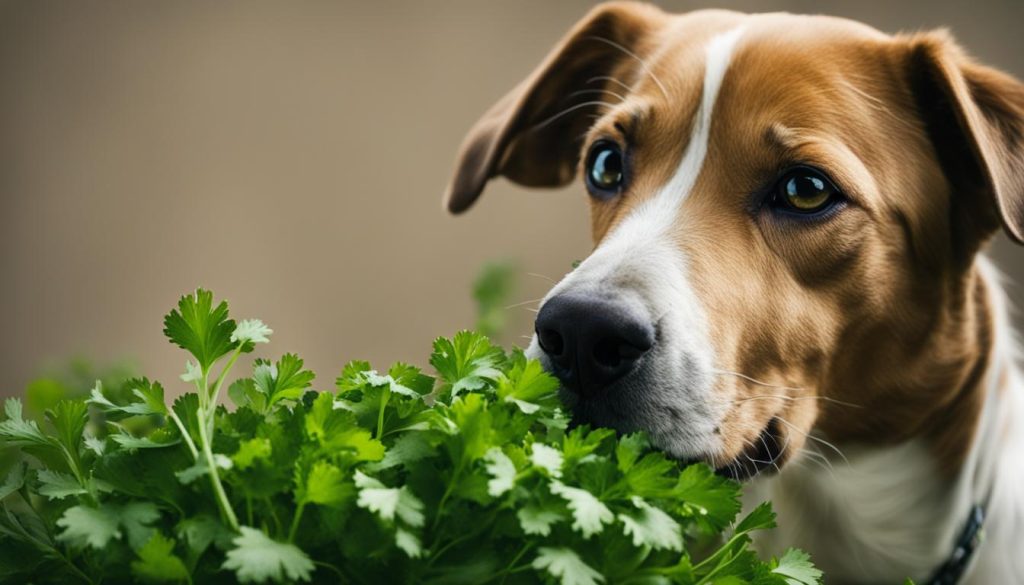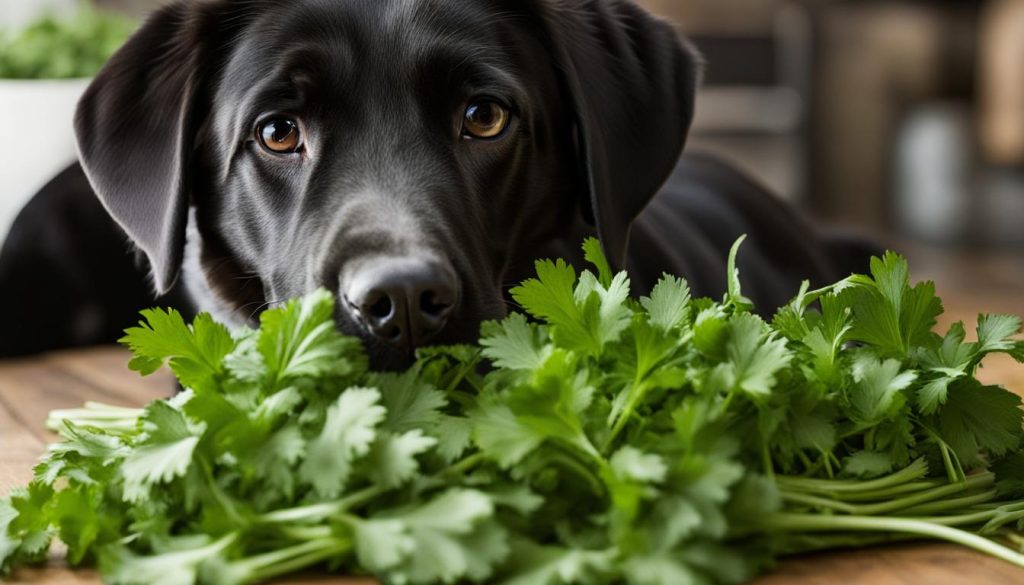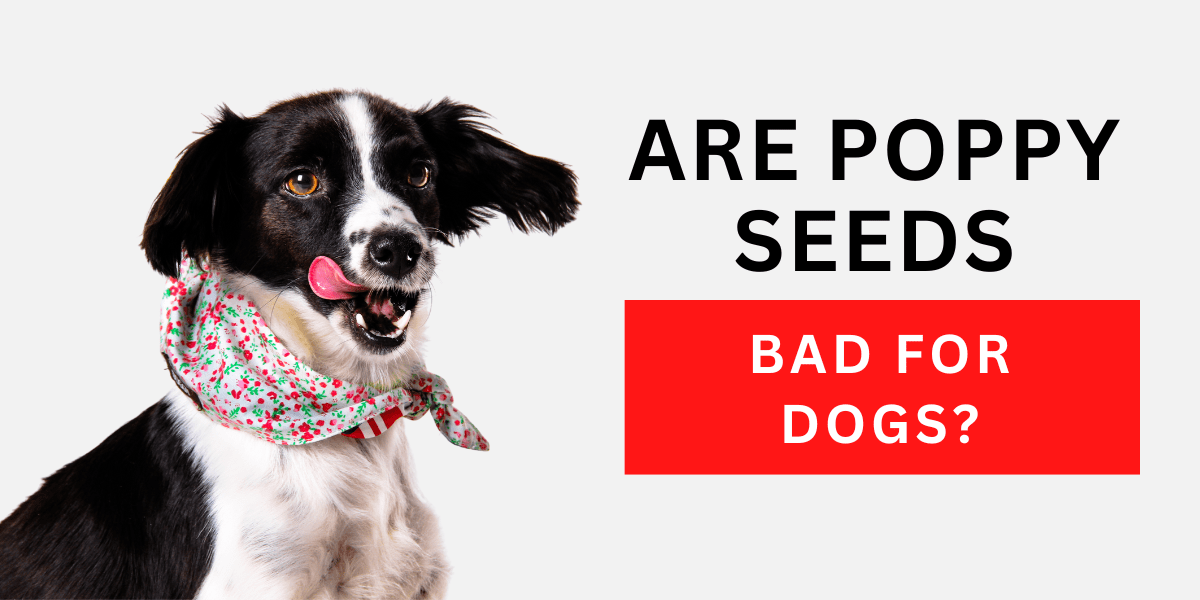As a pet owner who enjoys cooking with a variety of fresh herbs, I often find myself pondering over what’s safe to share with my canine companion. The question “can dogs eat cilantro” has crossed my mind more than once, leading me to dig deeper into the effects of this herb, also known as coriander, on our furry friends. It turns out that cilantro for dogs is not only non-toxic but it could also offer some health advantages when given in the right amounts.
Discovering that cilantro and dogs’ digestive systems could potentially harmonize was reassuring, considering how often it’s used in my kitchen. But I understand that—as with humans—every dog is an individual with unique tastes and tolerances. When I first introduced a sprinkle of cilantro to my dog’s meal, I watched carefully to ensure it sat well with her. My aim has always been the safety and happiness of my dog, and I’m always ready to remove any food that doesn’t sit right with her, even something as seemingly benign as cilantro.
Can Dogs Eat Cilantro? Yes, they can have it in small amounts.
- Cilantro, also known as coriander, is safe and non-toxic for dogs when consumed in moderation.
- Introducing cilantro to a dog’s diet must be done slowly, with close observation for any adverse reactions.
- This herb is a source of nutrients like vitamins A, C, and K, and it also offers calcium and magnesium.
- Dogs’ preferences vary, so some may not enjoy the taste of cilantro—start with a small amount to test their taste buds.
- Always prioritize your dog’s overall diet and health before introducing new foods such as cilantro.
Understanding the Safety of Cilantro for Dogs
As a pet owner, it’s paramount to verify what’s placed in the feeding bowl. When contemplating the addition of cilantro to my dog’s diet, I always prioritize safety first. Before integrating this aromatic herb into my furry friend’s meals, it’s essential to address a couple of pivotal questions. Let’s delve into the considerations necessary for the safe inclusion of cilantro in canine diets.
Is Cilantro Safe for Dogs?
One of the recurring questions I’ve encountered is, “Is cilantro safe for dogs?” The answer is reassuringly positive—cilantro is generally regarded as a secure option for canines when offered in moderate amounts. Rife with vitamins and minerals, the herb can complement a dog’s nutritional needs. However, like any new dietary addition, vigilance is needed to notice any unusual responses.

Recognizing Potential Allergic Reactions
While cilantro poisoning in dogs is a rare occurrence, the possibility of allergic reactions still looms. Not unlike humans, our four-legged companions may display signs of discomfort or hypersensitivity following the ingestion of certain foods. Symptoms like excessive scratching or breathing difficulties post-cilantro consumption demand prompt veterinary intervention.
The Right Amount of Cilantro for Dogs
Even with the benefits of cilantro for dogs in mind, I’m mindful to not overdo it. Moderation is key—starting with a mere pinch of this leafy green and observing for any adverse effects is the safest route. While it’s a gratifying sight to see my dog benefit from a flavor variety, establishing the proper serving size tailored to their dietary needs sustains that joy.
Can Dogs Eat Cilantro and Enjoy Its Flavor?
Exploring the culinary world with my dog is one of my delights, especially when it involves healthy, natural ingredients like cilantro. With its fresh, almost citrusy taste, cilantro has become a staple in my kitchen. However, when it comes to sharing this aromatic herb with my dog, I’ve wondered about cilantro as a dog treat. Can my furry friend appreciate the unique zest cilantro offers?
Cilantro in dog food is not unheard of. Some pets may enjoy the kick of flavor it provides. I’ve found that introducing a tiny pinch of cilantro into their meals can be an enjoyable surprise for their taste buds. Plus, thanks to cilantro’s breath-cleaning properties, it can also help freshen their breath—a win-win for both of us. I’ve noticed that my dog becomes quite intrigued by the new scent in his bowl and often gobbles up his food with more enthusiasm.
However, it’s essential to pay close attention to how your dog reacts to this new addition. The reality is, just like people, not all dogs take to the taste of cilantro. If you notice that your dog isn’t as excited about their cilantro-infused dinner, it’s best to respect their preference. There are plenty of other ways to ensure they’re getting beneficial nutrients without relying on cilantro. After all, our dogs’ happiness and comfort should always come first in our decisions.

Always remember, any changes to your dog’s diet should be approached with moderation and care. While cilantro can offer health benefits and a burst of flavor, it should never replace the core of their diet, and should only be served as a complement to their regular, nutritionally balanced meals.
Health Benefits of Cilantro for Canines
As a devoted dog owner, I’ve always been curious about the myriad of ways to enhance my furry friend’s health through diet. It’s exciting to discover the numerous benefits of cilantro for dogs, a common herb that is more than just a flavorful garnish. From its nutritional composition to its digestive benefits, cilantro offers an array of health advantages for our canine companions.
Fighting Infections with Antimicrobial Properties
Cilantro isn’t just a tasty addition to salsa; it’s a powerful herb with impressive antimicrobial properties that may support your dog in warding off infections. Its anti-fungal and anti-bacterial characteristics are particularly beneficial for the cilantro and dogs’ digestive system, creating a hostile environment for unwanted pathogens to take hold.
Essential Vitamins and Minerals in Cilantro
Who knew that a small bunch of cilantro could pack such a nutritional punch? This herb is brimming with essential vitamins and minerals that foster optimal health in dogs. Noteworthy are the antioxidants in cilantro that combat free radicals and the vitamin K, which is critical for bone health and proper blood clotting.
Cilantro’s Role in Canine Digestive Health
My experiences with adding cilantro to my dog’s meals have been positive, particularly concerning their digestion. A sprinkling of finely chopped leaves can enhance gut health, and many fellow pet owners report it aids in keeping their dogs’ digestive system on track.
Understanding the beneficial properties of cilantro has made me more confident in incorporating this herb into my dog’s diet. With its ability to fight infections, provide essential nutrients, and support a healthy digestive system, cilantro can be an excellent supplement to your dog’s balanced diet. Remember, moderation is key, and it’s vital to ensure that your pooch enjoys the flavor of cilantro before making it a regular part of their meals.
Incorporating Cilantro into Your Dog’s Diet Safely
As a devoted dog owner, I’m always looking for ways to enhance my furry friend’s diet with healthy options, and like many others, I’ve wondered how to safely feed my dog cilantro. In my experience, cilantro can be a zesty addition that provides both flavor and nutrition to your dog’s meals, but it’s crucial to introduce this herb properly to prevent any digestive issues or discomfort.
Introducing Cilantro Gradually
I learned that the key to adding cilantro in dog food is to do it slowly. I started by sprinkling a small pinch of finely chopped cilantro leaves over my dog’s regular food, which allows for easy digestion and lets me watch for any potential adverse reactions. It’s always best to err on the side of caution and let your dog’s digestive system adjust to the new ingredient.
Tips for Serving Cilantro to Dogs
In my quest to feed cilantro safely, I’ve found that using only the leaves is best. The stems can be tough and more difficult for dogs to digest. Finely chopping the leaves ensures that they can be mixed easily with other food items, enhancing the meal with minimal risk of gastrointestinal upset. Remember, cilantro should complement your dog’s diet, not be a staple.
When to Avoid Giving Cilantro to Your Dog
Though I’ve had a positive experience with cilantro, it’s important to note that there are times when this herb should be avoided. If my dog had shown any signs of stomach irritation or an allergic reaction, I would have stopped offering cilantro immediately. It’s crucial to consult your veterinarian if you notice any signs of discomfort or allergies, as they can best advise on your dog’s specific dietary needs.
Conclusion
As we wrap up our discussion on cilantro’s place in our furry friends’ diets, it’s clear that while cilantro and dogs’ digestive systems aren’t natural companions, this herb can indeed coexist with tail-wagging gusto when approached correctly. The key is moderation, recognizing that every dog has its own unique palate and potential sensitivities. Whether your pet revels in the zesty freshness or turns up their nose, this aromatic herb can offer more than just a taste sensation; it brings to the bowl a bouquet of health benefits.
Evaluating the Overall Impact of Cilantro on Dog Health
My investigative journey into the world of dogs and cilantro suggests that this leafy green can contribute positively to canine wellness. From its vitamins and minerals that bolster the immune system, to its antimicrobial properties that can aid in fighting off infections, cilantro makes for a noteworthy supplemental treat. However, an attentive eye should be kept on signs of cilantro allergies in dogs, ensuring that our pets continue to thrive without dietary discomfort.
Consulting with a Veterinarian Before Dietary Changes
It’s a mantra I stand by – consult your veterinarian before ushering in any dietary transitions for your four-legged companion. This professional guidance becomes particularly pressing if your dog has existing health conditions or if there’s any chance of interference with medication. In essence, the integration of cilantro into your dog’s diet should be done not just with enthusiasm for its benefits but also with care and respect for the individual needs of your cherished pet.
FAQ
Is Cilantro Safe for Dogs?
Yes, cilantro is safe for dogs to eat in moderation. It is not toxic, and its leaves contain essential nutrients beneficial to canine health. Nonetheless, it is important to introduce it slowly and watch for any undesirable reactions.
Recognizing Potential Allergic Reactions
Just like humans, dogs can have allergic reactions to foods, including herbs like cilantro. Signs of an allergic reaction may include itching, hives, swelling, or difficulty breathing. If you notice any of these symptoms after your dog eats cilantro, it’s important to seek veterinary attention right away.
The Right Amount of Cilantro for Dogs
The appropriate serving size depends on your dog’s size and dietary needs. It is best to start with a small amount, such as a pinch of finely chopped cilantro leaves mixed into their food, and never to make cilantro a large part of their diet.
Can Dogs Enjoy the Flavor of Cilantro?
Some dogs may enjoy the taste of cilantro, while others might not be fond of it. You can offer a small amount to your dog to see if they like it. If they do, cilantro can be used as a treat or a dietary supplement.
Fighting Infections with Antimicrobial Properties
Cilantro has anti-fungal and anti-bacterial qualities that could potentially help your dog to fight off infections, especially those affecting their digestive system.
Essential Vitamins and Minerals in Cilantro
Cilantro provides dogs with essential nutrients such as vitamins A, C, and K, and minerals like potassium and manganese, which support various aspects of canine health including vision, bone strength, and the immune system.
Cilantro’s Role in Canine Digestive Health
Cilantro has been known to aid in digestion for dogs. The herb can help settle minor stomach upset and promote a healthy digestive system when fed in moderate amounts.
Introducing Cilantro Gradually
It is best to introduce cilantro into your dog’s diet gradually. Start with a small amount and observe your dog’s reaction over time. Increase the quantity slowly if there are no adverse effects.
Tips for Serving Cilantro to Dogs
Serve only the cilantro leaves, finely chopped, and avoid the stems which can be harder to digest. Mix it in with their regular food as a garnish rather than a main ingredient.
When to Avoid Giving Cilantro to Your Dog
Avoid cilantro if your dog has shown an allergic reaction or any sort of sensitivity towards it in the past. Additionally, if your dog has a history of gastrointestinal issues, consult with your vet before introducing cilantro or any new food into their diet.
Consulting with a Veterinarian Before Dietary Changes
Always consult with a veterinarian before making significant changes to your dog’s diet, especially if they have preexisting health conditions or are on medication to ensure that the new food will not interfere with their health regimen.






